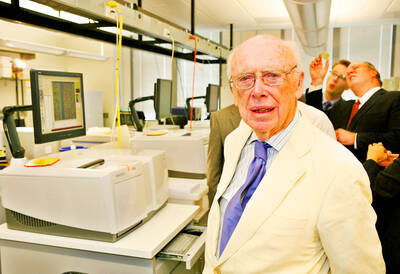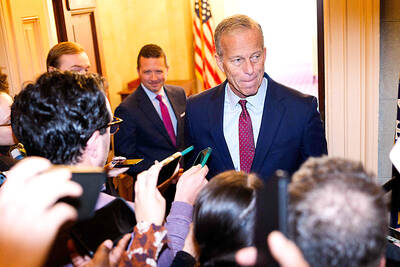Humans who dismiss birds as featherweights may revise their opinion when learning of crows, which not only can identify the face of someone who is a danger, but also teach others about the threat.
Intrigued by the behavior of wild American crows (Corvus brachyrhynchos) on their campus in Seattle, University of Washington scientists explored whether the birds would recall a face associated with a frightening ordeal.
The researchers donned the rubber mask of a caveman before trapping, banding and releasing seven crows.

Photo: Reuters
Thereafter, researchers wore either this “dangerous” mask or a neutral one — that of former US vice president Dick Cheney — and observed, as they walked along the college paths, how the flock of crows reacted.
The “crow magnon” mask prompted the birds into a collective response to a threat. They cawed and screeched, angrily flapped their wings and flicked their tail to warn of the danger, a behavior called scolding. However, the Cheney mask elicited no response.
The team broadened the experiment to four other sites beyond the university, this time using different masks made in latex by a mask maker. The faces were ordinary looking, either male or female, Asian or Caucasian. Forty-one birds were caught and banded.
As time passed, the number of birds scolding the “dangerous” face did not decline. Rather, the reverse happened.
At the university site, scolding rose from 20 percent of the birds after the banding to an astonishing 60 percent after five years.
“At the other sites, we only tested for a half year and there, 20 to 40 percent of crows scolded,” John Marzluff, a professor of wildlife science, said in an e-mail.
What caused the increase in scolding?
Some of the angry birds were the offspring of banded crows, who as fledglings had watched as their parents reacted to the perceived danger.
However, there were also unbanded crows, living up to 1.2km from the site. They joined in, apparently learning of the threat through the contagion of mobbing.
Facial recognition is essential for the crows, the study says. Some humans in the area put out food for the birds while others shoot them.
“Some of our sites were rather rural and the birds there are very wary, having been persecuted by people,” Marzluff said. “Urban crows are very attentive to people, having to sort the good providers from the dangerous.”
The crows are particularly intriguing because they have to juggle three potential sources of information, says the paper, which is published in a British journal, Proceedings of the Royal Society B: Biological Sciences.
The birds acquired information either first-hand, through their own experience; “vertically,” from their parents; or “horizontally” from other birds.
Managing this implies the birds have remarkable flexibility in processing information.
In evolutionary terms, animals have to make a trade-off when it comes to processing information.
Gaining information first-hand — about threats or food, for instance — is the most reliable way, but it is also potentially risky.
Acquiring it from trusted individuals is less costly, but also potentially less reliable, and even more so when the information comes from more distant sources.
The American crow is unlikely to be alone in its multi-tasking data processing.
“It has not been demonstrated, but I’m sure jackdaws and rooks [also] use both individual, horizontal and vertical methods of learning,” Marzluff said.

James Watson — the Nobel laureate co-credited with the pivotal discovery of DNA’s double-helix structure, but whose career was later tainted by his repeated racist remarks — has died, his former lab said on Friday. He was 97. The eminent biologist died on Thursday in hospice care on Long Island in New York, announced the Cold Spring Harbor Laboratory, where he was based for much of his career. Watson became among the 20th century’s most storied scientists for his 1953 breakthrough discovery of the double helix with researcher partner Francis Crick. Along with Crick and Maurice Wilkins, he shared the

China’s Shenzhou-20 crewed spacecraft has delayed its return mission to Earth after the vessel was possibly hit by tiny bits of space debris, the country’s human spaceflight agency said yesterday, an unusual situation that could disrupt the operation of the country’s space station Tiangong. An impact analysis and risk assessment are underway, the China Manned Space Agency (CMSA) said in a statement, without providing a new schedule for the return mission, which was originally set to land in northern China yesterday. The delay highlights the danger to space travel posed by increasing amounts of debris, such as discarded launch vehicles or vessel

IMPASSE: US President Donald Trump pressed to end the filibuster in a sign that he is unlikely to compromise despite Democrat offers for a delayed healthcare vote The US government shutdown stretched into its 40th day yesterday even as senators stayed in Washington for a grueling weekend session hoping to find an end to the funding fight that has disrupted flights nationwide, threatened food assistance for millions of Americans and left federal workers without pay. The US Senate has so far shown few signs of progress over a weekend that could be crucial for the shutdown fight. Republican leaders are hoping to hold votes on a new package of bills that would reopen the government into January while also approving full-year funding for several parts of government, but

TOWERING FIGURE: To Republicans she was emblematic of the excesses of the liberal elite, but lawmakers admired her ability to corral her caucus through difficult votes Nancy Pelosi, a towering figure in US politics, a leading foe of US President Donald Trump and the first woman to serve as US House of Representatives speaker, on Thursday announced that she would step down at the next election. Admired as a master strategist with a no-nonsense leadership style that delivered for her party, the 85-year-old Democrat shepherded historic legislation through the US Congress as she navigated a bitter partisan divide. In later years, she was a fierce adversary of Trump, twice leading his impeachment and stunning Washington in 2020 when she ripped up a copy of his speech to the